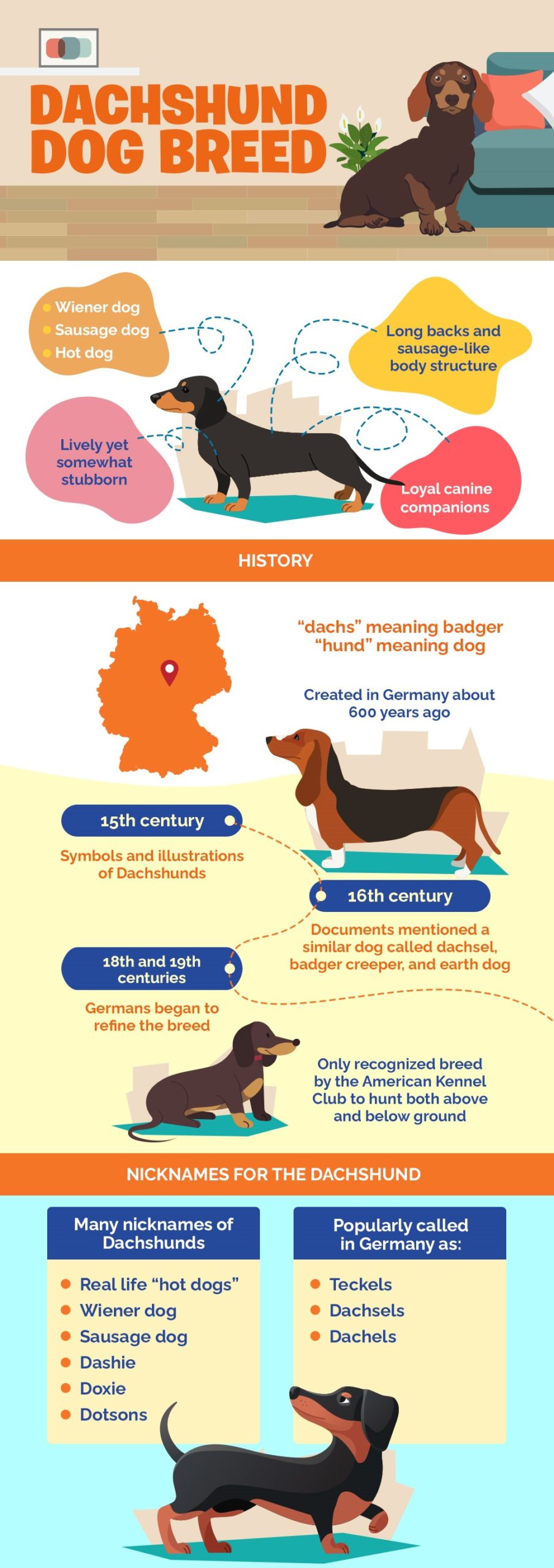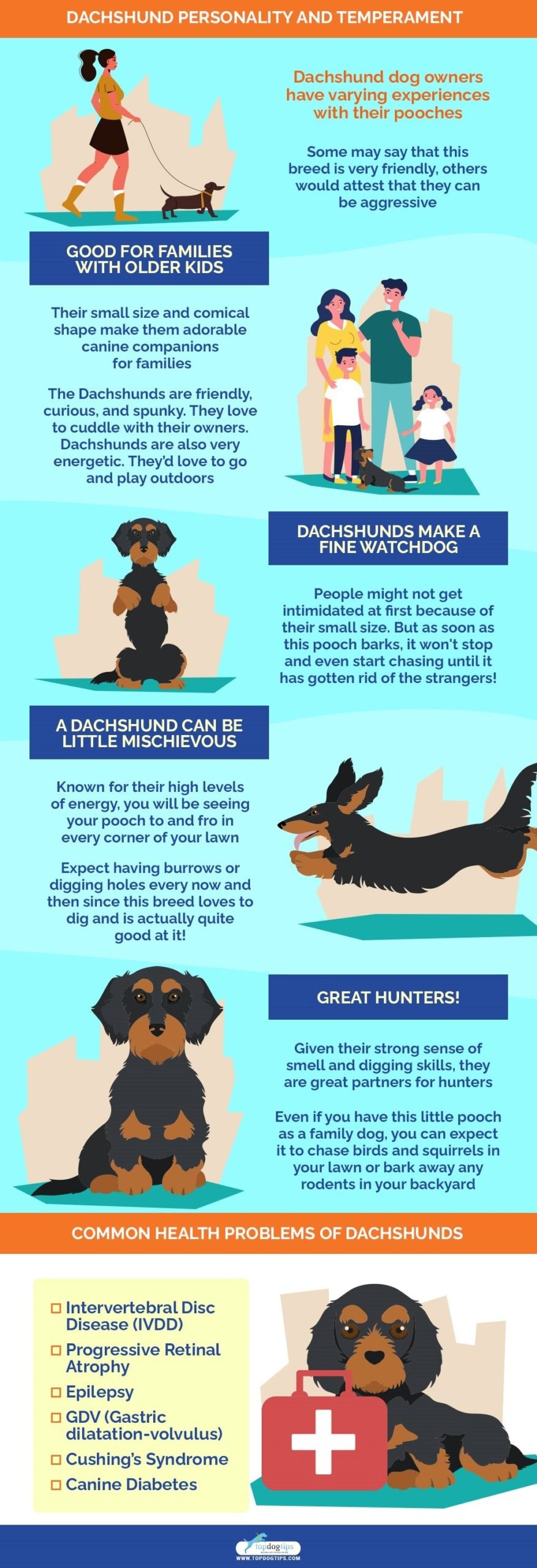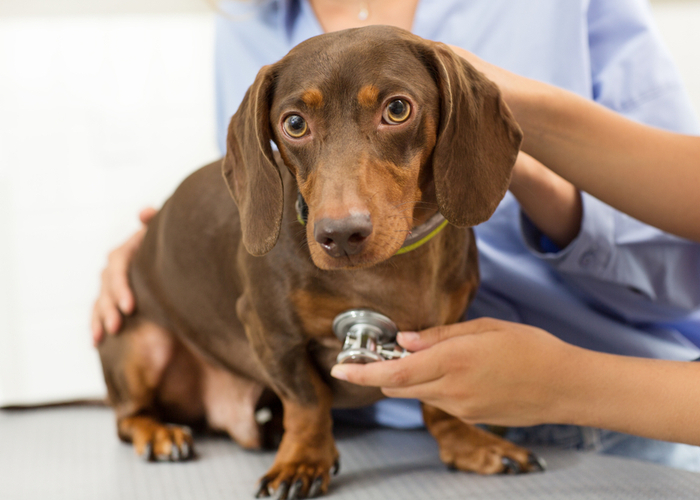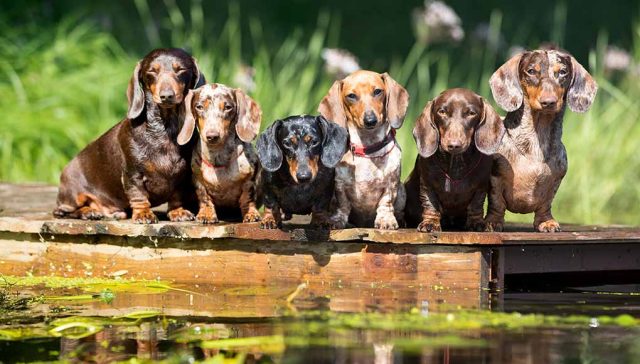
Table of Contents
- The Dachshund Dog Breed
- The History of the Dachshund Breed
- Nicknames for The Dachshund
- Dachshund Breed Standard
- Dachshunds Fun Facts You Should Know About
- Main Characteristics of Dachshunds
- The Lifespan of The Dachshund Dog Breed
- Dachshund Personality and Temperament
- Exercise and Activities
- Planning to have a Longhaired Dachshund? Here’s the Ultimate Care Guide
- Common Health Problems of Dachshunds
- Frequently Asked Questions about the Dachshund Breed:
- What Else Is There to Know About Dachshunds
- Final Thoughts to Know Your Dachshund Better
You probably thought they were literally hot dogs (pun intended). Some people also call them the wiener dog or sausage dog at first glance. You may have a hard time spelling it; their name is Dachshund.
In this article, you will learn all about these adorable, bubbly canines, so affectionately called the hot dog or wiener dog.
The Dachshund Dog Breed
Aside from their long backs and sausage-like body structure, they also have shorter legs. Their unique silhouette has made them instant superstars in the canine kingdom!
In fact, their body shape is so distinct and comical that you can’t avoid not seeing this breed in several cartoons and animations!
When it comes to Dachshunds, what pops into mind are the smooth, shiny dogs that come running with those little legs. However, they also come in different coat types, including the longhair Dachshund.
If you are looking for the best place to find everything there is to know about this lovable canine breed, then our Dachshund breed profile is just what you’re looking for!
Most people get their impressions of this dog breed by their appearance. But there’s actually more than meets the eye!
Despite being commonly seen as a lapdog, one thing you probably didn’t expect about dachshunds is that they are very brave. They wouldn’t back down on a fight!
The temperament of a dachshund makes them ideal dogs for hunting. They are lively yet somewhat stubborn. So, if they are out to get something, you might have a hard time pulling them off from their mission.
Still, Dachshunds are notably loyal canine companions. They love to spend time with their owners and follow them around wherever they go.
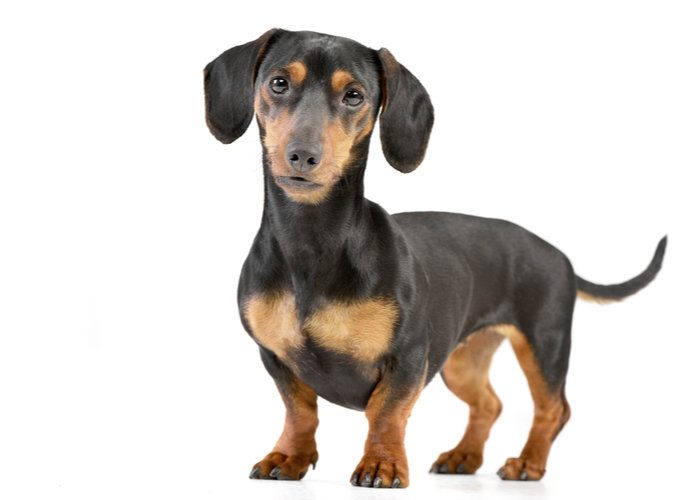
The History of the Dachshund Breed
This canine breed was created in Germany about 600 years ago. The word Dachshund came from the German words “dachs,” meaning badger, and “hund,” meaning dog.
There were symbols and illustrations of dogs in the 15th century that resembled the Dachshund.
In the 16th century, documents mentioned a dog similar to this little breed and even called it a dachsel, badger creeper, and earth dog.
In the 18th and 19th centuries, Germans began to refine the breed, making them brave dogs that could dig through burrows and fight off badgers.
You shouldn’t be underestimating this little pup. They were not only bred to hunt badgers, but they were also created to take down large animals like wild boars.
Their sleek, low bodies, strong legs, and large paws allowed them to dig tunnels and pursue prey underground. Their loud barks would ward off enemies and other animals on a hunt.
The Dachshund breed gained its way to becoming the only recognized breed by the American Kennel Club to hunt both above and below ground.
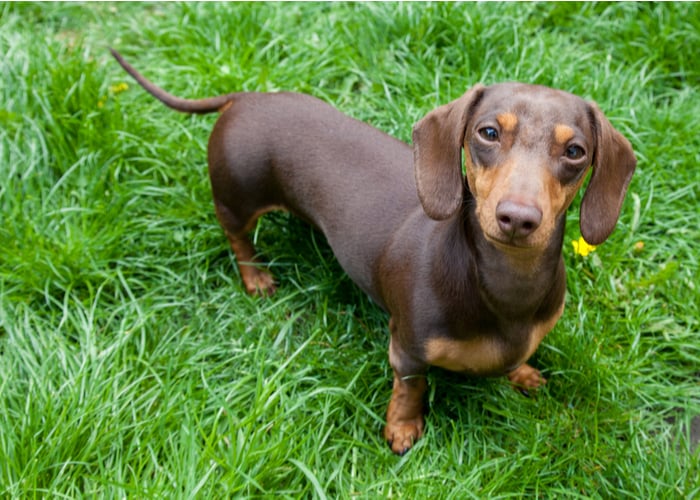
Nicknames for The Dachshund
While most of us would call this comical breed real-life “hot dogs,” there are many nicknames that Dachshunds go by:
- Wiener dog
- Sausage dog
- Dashie
- Doxie
- Dotsons
Popularly called in Germany as:
- Teckels
- Dachsels
- Dachels
Dachshund Breed Standard
In 1879, the breed standard was formally written. The German Dachshund Club was later formed in 1888.
The breed reached the United States of America by 1885, starting with 11 dogs registered in the American Kennel Club. In 1895, the Dachshund Club of America was founded.
In the early 1900s, Dachshunds began to receive much attention until the breed became one of the popular entries in the Westminster Kennel Club Show.
The breed suffered from a kind of pitfall during World War 1 in 1914. Dachshunds were often discriminated against because they were from Germany. Some dogs were even stoned.
As the 1950s emerged, Dachshunds regained their spotlight and were regarded more as family dogs rather than for hunting. Some parts of Europe still have them as hunting dogs.
Their growing popularity as family dogs, more specifically as lap dogs, has resulted in the creation of more varieties.
The longhaired Dachshund was one of the favorites of show dogs and for families.
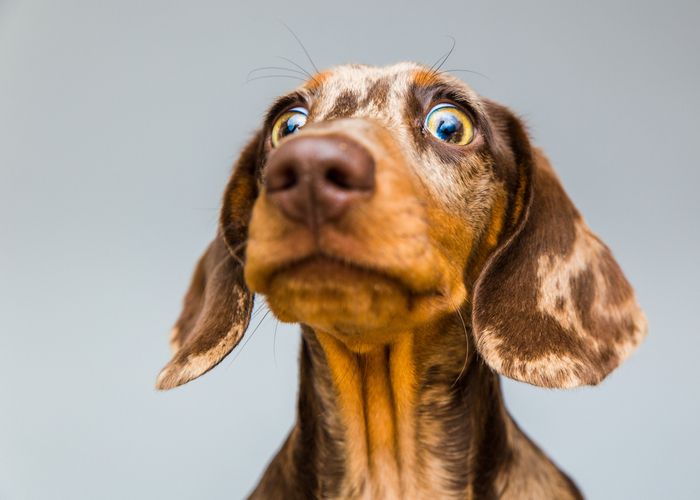
Dachshunds Fun Facts You Should Know About
Did you know?
Dachshund is often pronounced WRONG. Most English speakers would read it as “dash-hound” or “dash-ind”, but the correct pronunciation is “daks-hund.”
You probably didn’t know that, right? If you have been saying the word wrong all this time, you will be reading it differently from now on for the rest of the article.
There are a lot of things that you think you already know about Dachshunds, but this is no ordinary breed. In fact, Dachshunds are quite controversial. Here’s why…
- Hundreds of years ago in Germany, Dachshunds were bred in different sizes to hunt and kill large animals, like deer and boars.
- There are three coat varieties for this breed: smooth, wirehaired, and longhaired Dachshund (more of this later!)
- During World War 1, anyone who owned a Dachshund in America and England was considered a traitor since the breed was highly associated with Germans.
- Dachshunds were commonly called the “badger dog” during the postwar years to avoid associating it with the Germans.
- In 10 years, the breed jumped from the 28th rank to the 6th in the AKC and has maintained such ranking ever since.
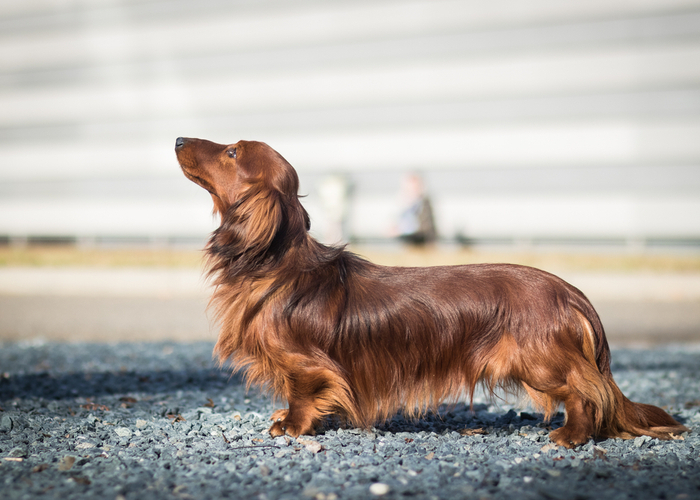
Main Characteristics of Dachshunds
As mentioned, Dachshunds come in varieties. You might have come across a longhaired Dachshund but hesitated if it’s actually the same breed.
Well, it is! There are three main coat varieties of Dachshund, which could be a contributing factor if you’re planning on getting one!
Hence, here are the main attributes of Dachshunds that you ought to know:
Appearance
The purebred Dachshund is distinguished by its elongated, long, low body and short, stubby legs. Their floppy ears and oval-shaped eyes complete that adorable pup look!
Dachshunds have pointed snouts and large nostrils. They also have muscular chests and clear breast bones, which makes them look tough and muscular — a perfect image for a hunting dog!
Their fur differs depending on the variety. The smooth coat type has short, shiny fur. As for the wirehaired variety, they have a thick, wiry texture that feels coarse when touched.
The longhaired Dachshund has flowing, silky coats that are longer around the stomach, legs, and tails. Their fur may even grow long enough to trail on the floor.
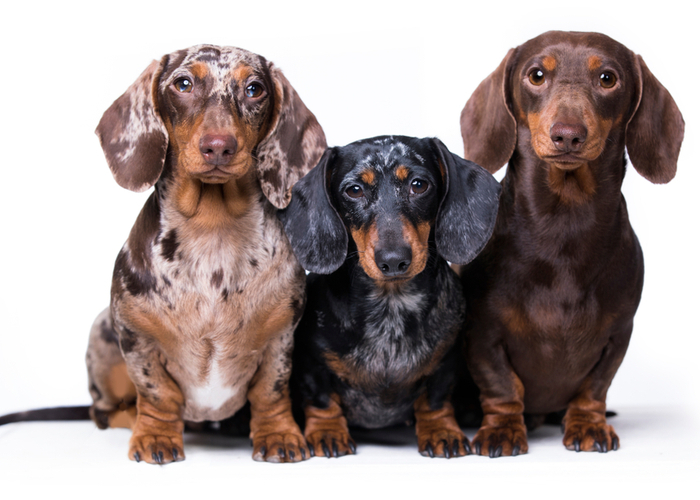
Size, Height, and Weight
There are two sizes of Dachshunds: standard and miniature. The standard size is about 8 to 9 inches, while the miniature size is 5 to 6 inches.
The miniature Dachshund would make a great lap dog for families. It only weighs around 11 pounds or less, while the standard ones weigh from 16 to 32 pounds.
Coat types
If you have trouble distinguishing between the three coat varieties, here is a vivid and more detailed description of each one.
Smooth
Dachshunds with a smooth coat are very popular in the United States. They have fur that is short and shiny.
The common color for the smooth variety is black, red, or cream. Some pooches have a dappled pattern with a mix of white and cream markings.
The ‘smooth’ Dachshund requires low maintenance, and you wouldn’t worry about them smelling bad all the time. You can even use only a damp cloth to clean them up!
Since their fur is very short, they might need to put on a sweater during winter or on cold walks. Their simple, elongated bodies also make it easier to put on those cute dog clothes!
Wirehaired
Their fur is thick, hard, and coarse on the topcoat yet softer in the undercoat. The length is longer than that of a smooth type but shorter than the longhaired Dachshund.
Hair is found all over the body except for the ears, eyebrows, and jaw. A common color among wirehaired Dachshunds is wild boar.
In cold climates, wire-haired Dachshunds don’t need sweaters. But this shouldn’t stop you from dolling up your pooch!
Unlike the smooth variety, this type would require frequent brushing. You also need to pay a regular visit to your groomer to have your dog’s coat stripped at least twice a year.
Longhaired
The longhaired Dachshund has long, sleek, soft hair. Their colors are quite the same with the smooth variety.
Because of their hair length, you might need to brush your pooch every day to avoid mats and tangles from forming.
When compared to other varieties, the longhaired Dachshund is said to have the most docile temperament. Still, this little pup is curious and lively and will always try to get your attention.
ALSO READ: Grooming Different Types of Dog Coats
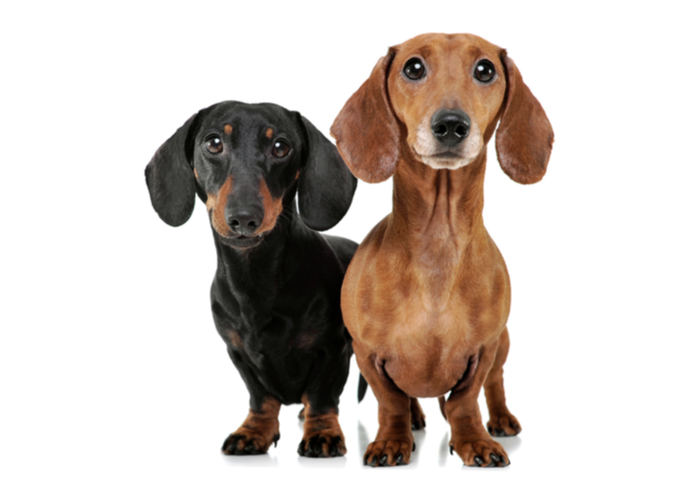
Colors
There are officially 12 colors according to the breed standard by the American Kennel Club. However, there are as many as 15 color varieties for the Dachshund breed:
- Black & Cream
- Black & Tan
- Blue & Tan
- Chocolate & Tan
- Cream
- Red
- Wheaten
- Wild Boar
- Blue & Cream
- Fawn (Isabella) & Tan
- Fawn (Isabella) & Cream
- Chocolate & Cream
- Black
- Chocolate
- Fawn
You commonly see Dachshunds in one solid color. Yet, this lovable breed can appear with several markings. Some patterns may even surprise you!
There are three markings listed in the breed standard. However, there can be as many as six types of markings for this breed.
- Dapple
- Sable
- Brindle
- Piebald
- Double Dapple
- Brindle Piebald
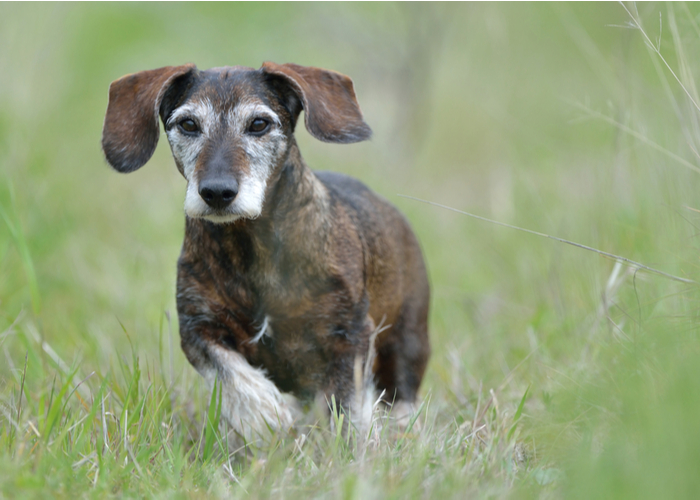
The Lifespan of The Dachshund Dog Breed
Dachshunds are generally a healthy breed. With that said, they can live from 12 to 15 years. They are less likely to acquire any health problems.
Still, it pays to take extra care of them to have them around for a long time. That means you need to provide adequate food, exercise, and grooming.
Dachshund Personality and Temperament
What is a Dachshund like? You already know what it looks like, and you have probably seen a lot of them on casual walks in the park or on the internet.
But, how does a Dachshund behave? If you are planning on getting one, you are probably wondering whether it would fit your lifestyle and personality.
Dachshund dog owners have varying experiences with their pooches. While some may say that this breed is very friendly, others would attest that they can be aggressive.
In some cases, it would depend on the variety. As mentioned, the longhaired Dachshund is considered more calm and docile compared to the smooth and wirehaired type.
Here’s what you need to know about the Dachshund's personality and temperament.
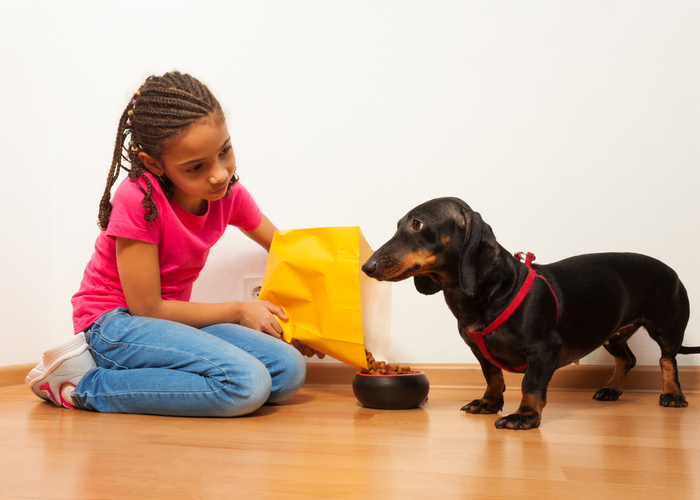
Good for Families with Older Kids
Do you plan to grow your family by adopting a Fido? Having a Dachshund is a great option for you!
This breed was considered a hunting dog hundreds of years ago, but its popularity spiked and it became one of the must-have family dogs!
Their small size and comical shape make them adorable canine companions for families. They wouldn’t take up much room if you are living in an apartment or small living space.
The Dachshunds are friendly, curious, and spunky. They love to cuddle with their owners. Dachshunds are also very energetic. They’d love to go and play outdoors.
You might want to surprise your kids with a new dog. But here’s a word of caution:
Dachshunds tend to nip and bite. They can be unpredictable around people and other dogs. That said, they need some time to socialize and get familiar with their environment.
Otherwise, they might get aggressive whenever they feel uncomfortable in their new home.
So, it’s best to get a Dachshund when you have older kids. This pooch could growl at smaller kids when they are pushed too far.
Older kids are just as active as your Fido will be. They may also help with training your new dog!
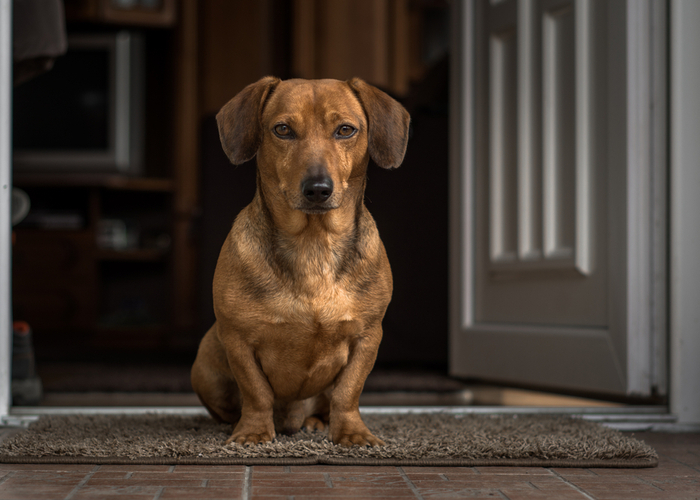
Dachshunds Make a Fine Watchdog
It’s a wonder how smaller dogs tend to be more vocal and bark more often. Dachshunds are no exemption.
People might not get intimidated at first because of their small size. But as soon as this pooch barks, it won't stop and even start chasing until it has gotten rid of the strangers!
Because of their loud bark and attentiveness, you will be alerted right away if anyone is approaching.
With the right training, you can make Dachshunds an effective watchdog without ever having to scare your guests away!
A Dachshund Can be Little Mischievous
Known for their high levels of energy, you will be seeing your pooch to and fro in every corner of your lawn.
Expect having burrows or digging holes every now and then since this breed loves to dig and is actually quite good at it!
Make sure to keep them inside the house when left alone. They tend to dig under the fence and get out!
When home alone, it is best not to leave your pooch for more than four hours. Who knows what they could do to your linens and furniture until you get home!
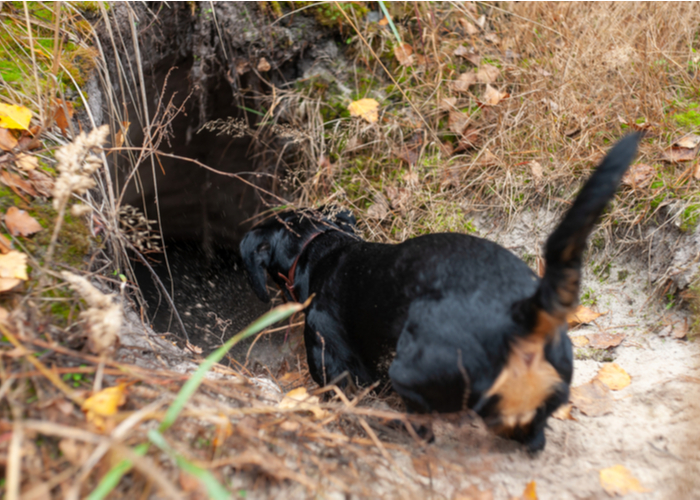
Great Hunters!
Despite their lapdog reputation, Dachshunds still remain to be one of the most reliable hunting dogs. Given their strong sense of smell and digging skills, they are great partners for hunters!
Even if you have this little pooch as a family dog, you can expect it to chase birds and squirrels in your lawn or bark away any rodents in your backyard.
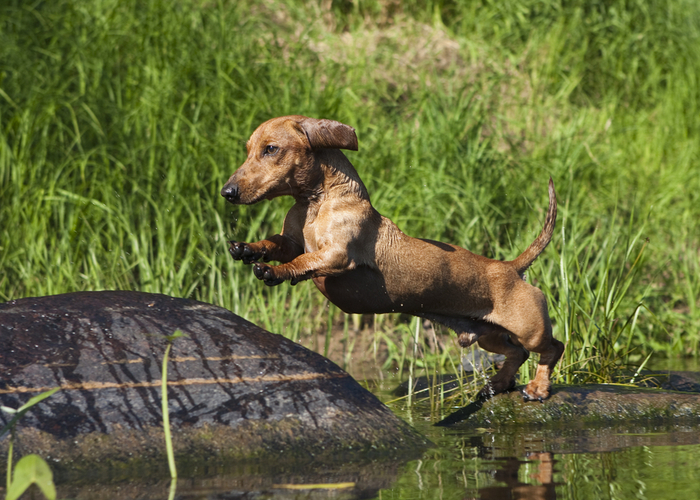
Exercise and Activities
Just because they’re lapdogs, it doesn’t mean they don’t need exercise. A Dachshund could get active by simply chasing around the room.
You could play some catch with them in your backyard and walk around the block. They can also do some running, but speed is not entirely their strength, given their stubby legs.
Still, being able to move around and play for a little would make them happy pooches!
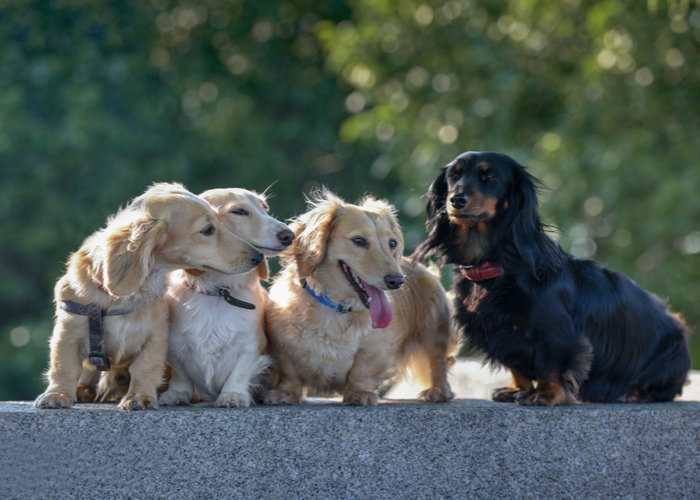
Planning to have a Longhaired Dachshund? Here’s the Ultimate Care Guide
It is not surprising that a lot of dog owners would choose a longhaired Dachshund over other varieties of this breed.
Their elegant, silky hair and lively personality are definitely a deciding factor!
A Few Things You Should Know About a Longhaired Dachshund
This breed variety is not ideal for a first-time dog owner. They tend to be a handful. They’re intelligent dogs, but they sometimes listen to you only if they’re interested.
They can be stubborn, and they usually want to have things their way. Still, they are trainable, especially while they’re still young.
A longhaired Dachshund is fond of chewing toys and treats and playing games. Just make sure not to play catch in muddy areas, as you would be having a hard time cleaning up your pooch.
How to Groom and Take Care of Them
Most dog owners choose a Dachshund for its low maintenance. There’s less to worry about its hair and grooming. But when you have a longhaired Dachshund, that’s an entirely different story!
This Dachshund variety has long, silky hair that can grow up to its toes and even longer! They require daily brushing and regular grooming.
You’re lucky that longhaired Dachshunds are moderate shedders. That means less hair fall whenever you’re brushing them up, and you wouldn’t worry much about cleaning up afterward.
Since its hair tends to grow almost every part of its body, it is best to occasionally trim near the eyebrows and beard for a clean look!
Longhaired Dachshund, or any of its variety for that matter, should have their nails cut monthly. However, this becomes a challenge to most dogs since they are pretty sensitive in that area.
ALSO READ: How to Groom a Dog: All-in-One Guide for Beginners
Common Health Problems of Dachshunds
They are a healthy breed, and you shouldn’t be expecting any physical problems until your dog’s old age.
One thing you should look out for your little pooch is their back. Because of their long body shape, their back is more prone to injuries and disc damage.
So, avoid getting him into any extensive activities like frisbee catch. Monitor his weight, too! An overweight Dachshund could mean more pressure on their spine.
Dachshunds don’t do well with stairs. Their short, stubby feet may not be long enough to make the next step. Carry them instead of leaving them to jump on couches or beds.
In a nutshell, there isn’t much to worry about the health of your wiener dog. Still, here are a few common health issues your Fido could possibly encounter.
Intervertebral Disc Disease (IVDD)
This is a common health problem associated with their body structure. Their body is long and too low, and they only have stubby legs for support.
Moving the wrong way and getting into accidents while playing could cause IVDD. Symptoms are usually the inability to move rear legs, lost bladder or bowel control, and paralysis.
Treatment depends on the severity of the case and could range from simple anti-inflammatory medications to extensive surgeries that remove damaged discs.
This is why you could see some Dachshunds going around in a doggie wheelchair. But you don’t want that to happen to your pooch. So, be gentle with your dog!
Progressive Retinal Atrophy
This is a degenerative eye disorder in dogs that causes blindness in the long run. The good news here is that it’s detectable before any symptoms show up.
It pays to visit your vet ophthalmologist annually for a check-up. There is even a DNA test to detect this disease in miniature longhaired Dachshunds.
Epilepsy
Most cases of epileptic seizures among Dachshunds are caused by genetics or an accident/injury.
In case this happens to your pooch, don't panic. Call your vet immediately. This problem is often managed with medications.
GDV (Gastric dilatation-volvulus)
It is also known as torsion or bloating. A bloated stomach may not seem much, but it is actually very fatal to dogs.
Dachshunds are susceptible to bloating because of their deep chest. When they can't burp or vomit, the blood flow is disrupted.
Blood pressure drops, and your pooch could go into shock. Without immediate medical attention, your Fido may die.
To avoid this from happening, monitor how your dog is doing. Common symptoms are swollen or hard stomach, excessive salivating, and retching.
Cushing’s Syndrome
It's a hormonal problem in dogs where too much cortisol is produced. It shows an imbalance of hormones in the pituitary or adrenal gland.
Cortisols are commonly known as the “stress hormone.” Having too much of this in their system can cause a significant change in their behavior, appetite, and bladder control.
The treatment would differ depending on the situation. Mild cases are controlled with medications, while severe cases require surgery and removal of glands.
Canine Diabetes
This is evident whenever a Dachshund is overweight. Common symptoms are frequent urination, thirst, and weight loss despite the usual diet.
It can be treated with a change in diet. In other cases, they would need their pooch to have regular insulin shots.
You can ask for health clearances from the breeder if ever you’re planning to get one. However, there are some health issues that don’t come up until the dog’s fully mature.
Frequently Asked Questions about the Dachshund Breed:
There are many factors to consider before getting your own Dachshund. If you already have one, there might be things you didn’t know about this energetic breed!
Here’s what people are asking:
Are Dachshunds good family dogs?
Yes, they are a lovable breed that enjoys the company of their owners. They are also reliable watchdogs, making your homes extra safe.
One thing you should consider with Dachshunds is that they may be difficult to train at first. This becomes a challenge when you have little children.
When they are already used to you and your kids, having these adorable pooches wouldn't be a problem.
Do Dachshunds like to cuddle?
This breed is actually loyal and very sweet to its owners. They would love to snuggle with you in bed, on the couch, or wherever possible at home.
Dachshunds are very overprotective. They would follow you around (even in the bathroom), making sure you're there and you're alright.
Do Dachshunds bark a lot?
Unfortunately, they do. In fact, they bark most of the time. It's because they're territorial. They bark if they see a stranger approaching or see something unfamiliar in their surroundings.
Dachshunds also have a bad case of separation anxiety. They bark before you get to the door. They even start barking when you're just getting the car keys or preparing to leave.
Can I leave my Dachshund at home alone?
It's not advisable to leave your little pooch for more than 4 hours or half a day. A bored Dachshund is a mischievous Dachshund!
They easily get bored and might start digging or scratching carpets and other furniture. Leave them a lot of chew toys to keep them occupied.
Are dachshunds hard to potty train?
Dachshunds are very challenging when it comes to potty training. They are very energetic hunting dogs. You'd expect their attention to be divided, always in the pursuit of tracking birds or squirrels.
Best to potty train them when they're young. And remember to be very patient. You can reward reinforcement through healthy dog treats.
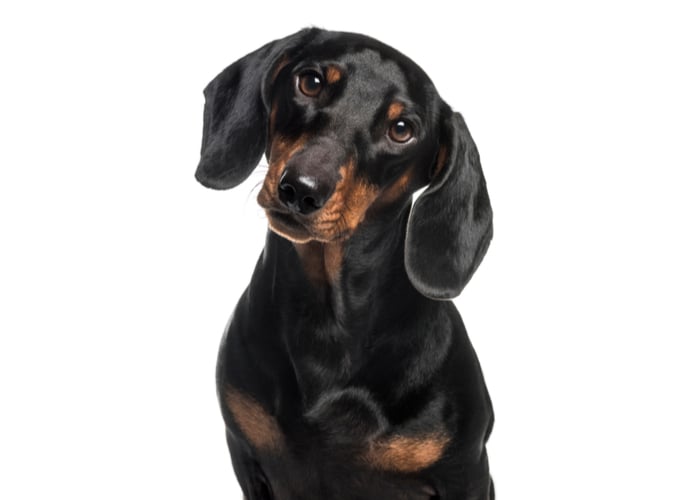
What Else Is There to Know About Dachshunds
Here are a few extra pointers and additional information about this lively breed:
Training
Known to be stubborn, Dachshund pups can be taught new skills and basic orders with reward-based training.
For starters, you can train them to use ramps. This is to prevent them from jumping on and off high places as it causes injuries to their long backs.
Keep your training sessions short. Dachshunds have a limited attention span, and they get bored with the same activities over again.
You can hold their favorite toy while training to get their attention. Feel free to get creative by visiting parks or putting up an obstacle course.
Crate training is also ideal for pups. Just like any dog, Dachshund puppies can be destructive. Dog crates can instill discipline in your young Fido, but don’t make it feel like a prison.
With the use of crates, they wouldn't be getting into mischief while you're out. Just make sure not to leave them there for the whole day.
Putting your Dachshunds in crates also allows them to get used to confinement. This is very helpful whenever you're traveling or they get hospitalized.
Nutrition
Dachshunds need ½ to 1 ½ cups of nutritious, quality dog food daily. Don’t get carried away by those puppy dog eyes, and avoid giving them table scraps all the time.
Monitor their food intake. Best to avoid dog food and cooked bones with high-fat content. Also, they have a keen sense of smell, and they tend to move food towards them with their snouts.
So, keep food out of reach!
ALSO READ: Recipe: Homemade Dog Food for Dachshunds
Socialization with Other Dogs
When it comes to other dogs, they get along fine if they are exposed as a puppy. Otherwise, you might have a hard time introducing your adult Doxie to a new dog.
Dachshunds are generally friendly with other dogs. However, they are proud and territorial. They bark whenever they feel threatened.
First encounters should be supervised as some breeds may not get along well. They often bark at larger dogs and would insist on being the top dog.
Final Thoughts to Know Your Dachshund Better
Reading this breed profile is helpful in understanding more about your little pooch. Still, it’s best to pay extra attention to your Dachshund as its needs would vary.
Find out what they like or what upsets them. Know their favorites. That way, you will be able to provide a healthy and happy living space for your Dachshund.
As dog owners, no one would understand your Fido better than you. Spend some extra time with your pooch. After all, who couldn’t resist cuddling and playing with such an adorable small breed?
If you’re planning on getting one, this breed profile is the ultimate guide. However, if you want more information, you may go to the nearest vet and get the resources or recommendations you need.


